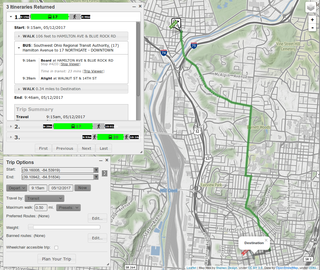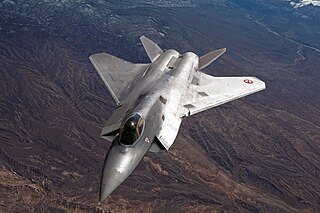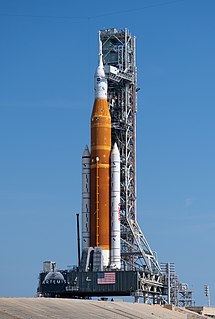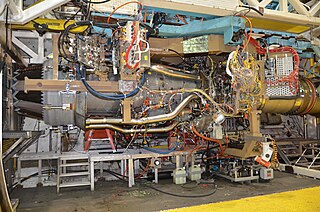Related Research Articles

The Defense Advanced Research Projects Agency (DARPA) is a research and development agency of the United States Department of Defense responsible for the development of emerging technologies for use by the military.

Pratt & Whitney is an American aerospace manufacturer with global service operations. It is a subsidiary of Raytheon Technologies. Pratt & Whitney's aircraft engines are widely used in both civil aviation and military aviation. Its headquarters are in East Hartford, Connecticut. As one of the "big three" aero-engine manufacturers, it competes with General Electric and Rolls-Royce, although it has also formed joint ventures with both of these companies. In addition to aircraft engines, Pratt & Whitney manufactures gas turbines for industrial and power generation, and marine turbines. In 2017, the company reported that in 2014 they had 38,737 employees supporting more than 11,000 customers in 180 countries around the world. In 2013, Pratt & Whitney's revenue totaled $14.5 billion.

Unreal Engine (UE) is a 3D computer graphics game engine developed by Epic Games, first showcased in the 1998 first-person shooter game Unreal. Initially developed for PC first-person shooters, it has since been used in a variety of genres of games and has seen adoption by other industries, most notably the film and television industry. Written in C++, the Unreal Engine features a high degree of portability, supporting a wide range of desktop, mobile, console and virtual reality platforms.

The Boeing X-45 unmanned combat air vehicle is a concept demonstrator for a next generation of completely autonomous military aircraft, developed by Boeing's Phantom Works. Manufactured by Boeing Integrated Defense Systems, the X-45 was a part of DARPA's J-UCAS project.
Sophos Group plc is a British based security software and hardware company. Sophos develops products for communication endpoint, encryption, network security, email security, mobile security and unified threat management. Sophos is primarily focused on providing security software to 1- to 5,000-seat organizations. While not a primary focus, Sophos also protects home users, through free and paid antivirus solutions intended to demonstrate product functionality. It was listed on the London Stock Exchange until it was acquired by Thoma Bravo in February 2020.

History is an American pay television network and flagship channel owned by A&E Networks, a joint venture between Hearst Communications and the Disney General Entertainment Content division of the Walt Disney Company.

The GTRE GTX-35VS Kaveri is an afterburning turbofan project developed by the Gas Turbine Research Establishment (GTRE), a lab under the Defence Research and Development Organisation (DRDO) in Bengaluru, India. An Indian design, the Kaveri was originally intended to power production models of the HAL Tejas Light Combat Aircraft (LCA) being built by the Aeronautical Development Agency. However, the Kaveri programme failed to satisfy the necessary technical requirements or keep up with its envisaged timelines and was officially delinked from the Tejas programme in September 2008.
No instruction set computing (NISC) is a computing architecture and compiler technology for designing highly efficient custom processors and hardware accelerators by allowing a compiler to have low-level control of hardware resources.

A journey planner, trip planner, or route planner is a specialized search engine used to find an optimal means of travelling between two or more given locations, sometimes using more than one transport mode. Searches may be optimized on different criteria, for example fastest, shortest, fewest changes, cheapest. They may be constrained, for example, to leave or arrive at a certain time, to avoid certain waypoints, etc. A single journey may use a sequence of several modes of transport, meaning the system may know about public transport services as well as transport networks for private transportation. Trip planning or journey planning is sometimes distinguished from route planning, which is typically thought of as using private modes of transportation such as cycling, driving, or walking, normally using a single mode at a time. Trip or journey planning, in contrast, would make use of at least one public transport mode which operates according to published schedules; given that public transport services only depart at specific times, an algorithm must therefore not only find a path to a destination, but seek to optimize it so as to minimize the waiting time incurred for each leg. In European Standards such as Transmodel, trip planning is used specifically to describe the planning of a route for a passenger, to avoid confusion with the completely separate process of planning the operational journeys to be made by public transport vehicles on which such trips are made.
HeroEngine is a 3D game engine and server technology platform originally developed by Simutronics Corporation specifically for building MMO-style games. At first developed for the company's own game Hero's Journey, the engine won multiple awards at tradeshows, and has since been licensed by other companies such as BioWare Austin and Stray Bullet Games.

A sixth-generation fighter is a conceptualized class of jet fighter aircraft design more advanced than the fifth-generation jet fighters that are currently in service and development. Several countries have announced the development of a sixth-generation aircraft program, including the United States, Japan, Russia, the United Kingdom, France and China. The first sixth-generation fighters are expected to enter service in the 2030s.

Ghatak is an autonomous jet powered stealthy unmanned combat air vehicle (UCAV), being developed by Aeronautical Development Establishment (ADE) of the Defence Research and Development Organisation (DRDO) for the Indian Air Force. The design work on the UCAV is to be carried out by Aeronautical Development Agency (ADA). Autonomous Unmanned Research Aircraft (AURA) was a tentative name for the UCAV. Details of the project are classified.

Future Vertical Lift (FVL) is a plan to develop a family of military helicopters for the United States Armed Forces. Five different sizes of aircraft are to be developed, sharing common hardware such as sensors, avionics, engines, and countermeasures. The U.S. Army has been considering the program since 2004. FVL is meant to develop replacements for the Army's UH-60 Black Hawk, AH-64 Apache, CH-47 Chinook, and OH-58 Kiowa helicopters. The precursor for FVL is the Joint Multi-Role (JMR) helicopter program.
The Armored Systems Modernization (ASM) was a U.S. Army combat vehicle procurement program canceled in 1992. The Army sought to develop a family of six armored vehicles based on two common chassis, one heavy and one medium, which would both share commonalities. Systems that the ASM sought to replace included the M1 Abrams main battle tank, M109 howitzer and M2 Bradley infantry fighting vehicle. The Army spun out several of the systems—Advanced Field Artillery System, Line-of-Sight Anti-Tank and the Armored Gun System—after canceling the program, but all of these programs were eventually canceled.

The Space Launch System is an American super heavy-lift expendable launch vehicle under development by NASA since 2011. The first launch, designated Artemis 1, is scheduled for a period between 27 September and 4 October 2022 from Kennedy Space Center. It replaces the Ares I and Ares V launch vehicles, which were cancelled along with the rest of the Constellation program, a previous program aimed to return to the Moon. The SLS is intended to become the successor to the retired Space Shuttle, and the primary launch vehicle of NASA's deep space exploration plans through the 2020s. Crewed lunar flights are planned as part of the Artemis program, leading to a possible human mission to Mars. The SLS is being developed in three major phases with increasing capabilities: Block 1, Block 1B, and Block 2. As of August 2019, SLS Block 1 launch vehicles are to launch the first three Artemis missions and five subsequent SLS flights are planned to use Block 1B, after which all flights will use Block 2.

Information technology (IT) is the use of computers to create, process, store, retrieve, and exchange all kinds of data and information. IT is typically used within the context of business operations as opposed to personal or entertainment technologies. IT forms part of information and communications technology (ICT). An information technology system is generally an information system, a communications system, or, more specifically speaking, a computer system — including all hardware, software, and peripheral equipment — operated by a limited group of IT users.

Vulcan Centaur is a two-stage-to-orbit, heavy-lift launch vehicle that is under development by the United Launch Alliance (ULA) since 2014 with an initial flight expected no earlier than December 2022. It is principally designed to meet launch demands for the U.S. government's National Security Space Launch (NSSL) program for use by the United States Space Force and U.S. intelligence agencies for national security satellite launches. The maiden flight is slated to launch Astrobotic Technology's Peregrine lunar lander for NASA's Commercial Lunar Payload Services (CLPS) program.

The CRAIC CR929, formerly known as Comac C929, is a planned long-range 250-to-320-seat wide-body twinjet airliner family to be developed by CRAIC, a joint-venture between Chinese Comac and Russian United Aircraft Corporation (UAC), to challenge the Airbus and Boeing duopoly. Construction of the first prototype began by September 2021.

The Sikorsky–Boeing SB-1 Defiant is the Sikorsky Aircraft and Boeing entry for the United States Army's Future Vertical Lift program, succeeding the Joint Multi-Role (JMR) initiative. It is a compound helicopter with rigid coaxial rotors, powered by two Honeywell T55 turboshaft engines; it first flew on 21 March 2019.

The Pratt & Whitney XA101 is an American adaptive cycle engine demonstrator being developed by Pratt & Whitney for the Lockheed Martin F-35 Lightning II and form the basis for the propulsion system for the United States Air Force's sixth generation fighter program, the Next Generation Air Dominance (NGAD).
References
- ↑ Cox, John (24 July 1995). "CA plans real-time scheduling engine". Network World. Network World. Retrieved 8 July 2015.